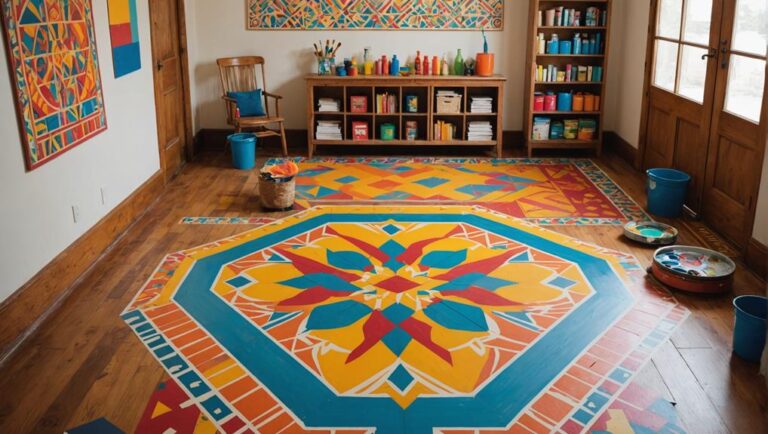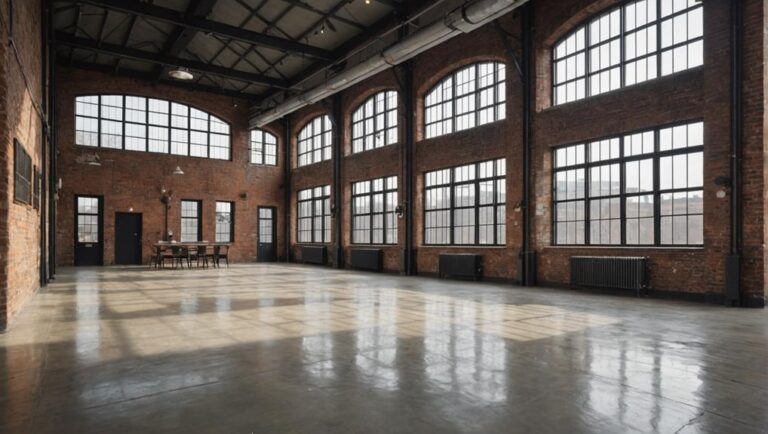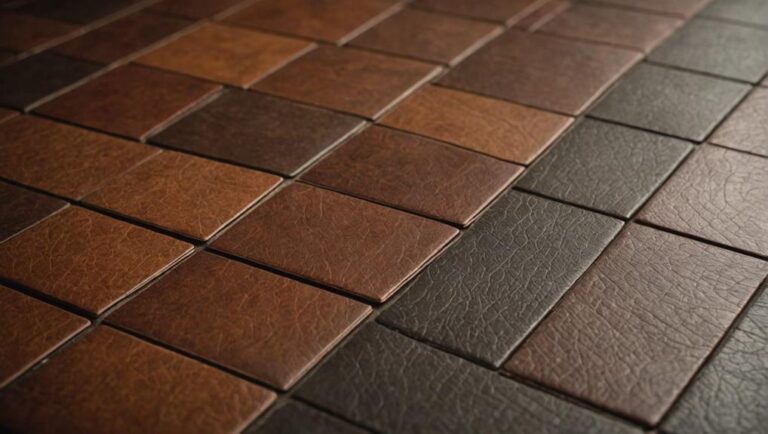Restoring Victorian-style tile flooring involves careful assessment and attention to detail. Start by inspecting for cracks, chips, or fading colors, and document your findings. Use pH-neutral cleaning solutions to maintain the integrity of the tiles while performing regular sweeps and gentle mops. For repairs, fill cracks with epoxy and use color-matched grout for chips. After regrouting, make certain to seal the tiles to protect against moisture and stains. Remember, understanding the historical significance and original craftsmanship is essential for authenticity. Exploring the precise restoration techniques will deepen your appreciation for the artistry behind these exquisite tiles.
Understanding Victorian Tile Characteristics
When you explore the world of Victorian tile flooring, you'll quickly notice that these tiles are not just decorative elements; they embody a rich historical narrative. The Victorian tile history spans from the mid-19th century, a period marked by industrial innovation and a revival of traditional craftsmanship. This era witnessed the emergence of intricate designs often inspired by Gothic, Islamic, and Renaissance motifs, reflecting a blend of cultural influences that enriched the aesthetic appeal of Victorian interiors.
Victorian tiles are typically made from clay or ceramic, with vibrant colors achieved through various glazing techniques. Their characteristic geometric patterns and elaborate floral designs serve not only as artistic expressions but also as functional flooring solutions that were both durable and easy to maintain. The use of encaustic tiles, where the pattern is built into the tile itself rather than merely painted on, showcases the era's commitment to craftsmanship and quality.
You'll find that safety is an important consideration in these historical tiles. Many original Victorian tiles contain lead glazes, which can pose health risks if the tiles deteriorate. Understanding the design influences and historical context behind Victorian tile flooring allows you to appreciate its beauty while being mindful of any potential hazards. By recognizing these characteristics, you can guarantee that your restoration efforts honor the integrity of the original designs while safeguarding your environment for years to come.
Assessing the Condition of Your Tiles
To effectively assess the condition of your Victorian tiles, you'll want to start with a meticulous visual inspection, noting any signs of wear or damage. Identifying the types of damage—such as cracks, chips, or discoloration—will guide your restoration efforts and help preserve the historical integrity of the flooring. Additionally, understanding proper cleaning and maintenance techniques is essential for both immediate restoration and long-term care.
Visual Inspection Techniques
A thorough visual inspection of your Victorian-style tile flooring is essential for understanding its condition and determining the necessary restoration steps. By employing effective inspection methods, you can identify visual cues that indicate potential issues. Here are some key aspects to evaluate during your assessment:
- Color Fading: Look for areas where the tiles have lost their vibrant hues.
- Cracks and Chips: Examine the surface for any noticeable damage that could worsen over time.
- Grout Integrity: Check for crumbling or discolored grout, as this can lead to water damage.
- Surface Stains: Identify stains that may require special cleaning techniques to restore the tile's original appearance.
As you conduct your visual inspection, use a flashlight to illuminate any hidden corners and bring out surface imperfections. Document your findings to establish a clear plan for restoration. Remember, early detection of problems can prevent costly repairs later on. By being methodical in your approach, you'll guarantee a safer and more effective restoration process for your cherished Victorian tiles.
Identifying Damage Types
Over time, Victorian-style tile flooring can exhibit various types of damage that require careful evaluation for effective restoration. Understanding the common damage types is important for determining the appropriate repair methods. One frequent issue is cracking, which can occur due to shifting foundations or heavy impacts. These cracks can compromise both the aesthetic and structural integrity of your tiles.
Another common damage type is chipping, often resulting from everyday wear or furniture movement. It's important to inspect edges and corners closely, as these areas are particularly vulnerable. Stains, whether from spills or age, can also detract from the beauty of your flooring; identifying the source will help in selecting proper cleaning and repair techniques.
Additionally, you might find loose tiles, which often indicate underlying issues such as water damage or poor installation. Addressing this promptly is critical to prevent more extensive damage. By carefully evaluating these conditions, you can choose effective repair methods, whether it's re-grouting, replacing individual tiles, or employing specialized restoration techniques. Prioritizing safety throughout this evaluation guarantees that your beautiful Victorian tiles can be restored to their former glory.
Cleaning and Maintenance Tips
Many homeowners overlook the importance of regular cleaning and maintenance when it comes to preserving the beauty of Victorian-style tile flooring. This unique flooring, characterized by its intricate patterns and vibrant colors, requires a thoughtful approach to cleaning and assessment. Here are essential tips to keep your tiles in peak condition:
- Use pH-neutral cleaning solutions to avoid damaging the tile's glaze.
- Establish a maintenance schedule that includes regular sweeping and mopping.
- Inspect tiles frequently for signs of wear or damage, such as cracks or discoloration.
- Utilize soft brushes or cloths to prevent scratching the surface.
Gathering Necessary Tools and Materials
When starting on the task of restoring Victorian-style tile flooring, it is essential to assemble a range of tools and materials that reflect both the craftsmanship of the era and the specific requirements of your project. Your tool selection should prioritize both functionality and safety. Important tools include a tile cutter, chisel, hammer, and a grout float. These will allow you to work efficiently while minimizing the risk of injury. Don't forget safety gear like gloves and protective eyewear, which are critical for safeguarding against sharp tiles and dust.
Material sourcing is another key aspect. You'll need high-quality tiles that match the historical aesthetic of your flooring. Research local suppliers or online marketplaces specializing in reclaimed or reproduction Victorian tiles. Confirm the tiles you select are durable and suitable for your specific environment. Additionally, consider the type of grout and adhesive—opt for ones that are breathable to accommodate the natural movement of the tiles over time.
Cleaning Techniques for Restoration
With your tools and materials gathered, the next step in restoring Victorian-style tile flooring is to focus on effective cleaning techniques that will prepare the surface for any necessary repairs or replacements. Understanding the historical significance of these tiles, you'll want to employ cleaning methods that prioritize both safety and tile preservation.
Start by evaluating the type of dirt and grime that has accumulated. Victorian tiles often attract dust and oils, which can degrade the tile's finish over time. Consider these essential cleaning methods:
- Dry Dusting: Use a soft broom or vacuum with a brush attachment to remove loose dirt.
- Gentle Mopping: Mix a mild pH-neutral cleaner with warm water, avoiding harsh chemicals that could damage the tiles.
- Spot Cleaning: For stubborn stains, apply a damp cloth with a small amount of cleaner directly to the affected area.
- Natural Solutions: Vinegar diluted with water can help lift grime without risking tile integrity.
As you clean, take care to avoid excess water, which can seep into the grout and lead to mold or warping. Use microfiber cloths for drying and buffing, as they're less abrasive and help maintain the tile's sheen. By employing these methods, you'll not only restore the beauty of your Victorian tiles but also guarantee their longevity, allowing future generations to appreciate their historical charm.
Repairing Cracks and Chips
When addressing cracks and chips in your Victorian tile flooring, it's crucial to first identify the sources of damage, which can range from improper installation to environmental factors. Once you've pinpointed these causes, you can employ effective filling and sealing techniques to restore the tiles' integrity and aesthetic appeal. Understanding these steps not only preserves the historical value of your flooring but also guarantees its longevity for future generations.
Identifying Damage Sources
Cracks and chips in Victorian-style tile flooring can be both a visual and structural concern, often stemming from a variety of sources. Understanding these sources is essential for maintaining the integrity of your flooring. Several factors can contribute to these damages, including:
- Moisture intrusion: Water can seep through cracks or improper sealing, leading to further deterioration.
- Structural issues: Settling foundations or shifting soil can create stress on the tiles, resulting in cracks.
- Temperature fluctuations: Extreme changes in temperature can cause tiles to expand and contract, potentially leading to chips.
- Heavy impacts: Dropped objects or furniture can chip tiles, especially if they're already compromised.
Filling and Sealing Techniques
How can you effectively restore the beauty of your Victorian-style tile flooring while guaranteeing its longevity? First, it's essential to address any cracks and chips promptly. Utilize appropriate filling techniques, such as epoxy or color-matched grout, to mend gaps seamlessly. Epoxy, known for its strength and durability, is particularly useful for larger cracks, while grout works well for smaller chips. When applying these materials, make certain to clean the area thoroughly, removing any dust or debris to guarantee proper adhesion.
Once you've filled the damaged areas, consider the sealing methods that will protect your tiles from future harm. A high-quality penetrating sealer can safeguard against moisture and stains, which are common threats to Victorian tiles. Apply the sealer evenly with a brush or roller, taking care to cover all filled areas adequately.
Always prioritize safety by wearing gloves and guaranteeing proper ventilation during this process. By implementing these filling and sealing techniques, you'll not only restore the aesthetic appeal of your flooring but also extend its life, maintaining the historical integrity of your beautiful Victorian home.
Regrouting and Sealing Tiles
The integrity of Victorian-style tile flooring often hinges on the meticulous process of regrouting and sealing. Over time, the grout can become worn or discolored, compromising the overall aesthetic and structural integrity of the flooring. By employing effective regrouting methods and high-quality sealing products, you can restore the beauty and durability of your tiles while ensuring their longevity.
To get started, consider these essential steps:
- Assess the Condition: Inspect the grout lines for cracks, discoloration, or mold.
- Choose Appropriate Materials: Select a grout that complements the historical context of your tiles.
- Employ Correct Techniques: Use a grout removal tool to eliminate old grout safely.
- Seal for Protection: After regrouting, apply a suitable sealing product to prevent future damage.
When selecting regrouting methods, opt for ones that suit the specific type of tile and its historical significance. For instance, using a traditional sanded grout can enhance the authenticity of your restoration. After the regrouting process, sealing products are vital. They not only protect the grout from staining but also prevent moisture penetration, which can lead to mold and damage over time.
Enhancing Colors and Patterns
Victorian-style tile flooring, with its intricate designs and vibrant hues, tells a story of craftsmanship and artistry from a bygone era. To truly appreciate these historical pieces, you'll often want to take into account color enhancement and pattern restoration. These processes not only revive the visual appeal of your tiles but also guarantee their integrity and safety.
Color enhancement involves applying specialized treatments that bring back the original vibrancy of the tiles. Over time, dirt, grime, and fading can diminish their beauty. Using safe, non-toxic cleaning solutions can effectively remove surface deposits without harming the tiles. After cleaning, a color enhancer can be applied, penetrating the tile's surface to rejuvenate its hues. This step is vital for maintaining the historical accuracy of your flooring.
Pattern restoration is equally important. Many Victorian tiles feature complex geometric designs that can become obscured due to wear or damage. You'll want to assess the patterns closely, identifying areas that require repair. Using a combination of professional-grade tools and materials, you can carefully fill in missing pieces or restore faded sections. It's essential to choose materials that match the original tiles in color and texture to maintain authenticity.
Both color enhancement and pattern restoration require an analytical approach to guarantee that the historical essence of the flooring is preserved. By investing time and effort in these processes, you'll not only enhance the aesthetic appeal of your Victorian-style tile flooring but also honor the artistry that has stood the test of time.
Preventative Care for Longevity
To guarantee the longevity of your Victorian-style tile flooring, implementing a consistent preventative care routine is essential. These tiles, often crafted from terracotta, ceramic, or encaustic materials, require specific attention to maintain their unique beauty and integrity. By incorporating effective preventative measures into your regular cleaning and maintenance regimen, you can greatly enhance tile preservation.
Here are some key practices to take into account:
- Regular Sweeping: Dust and debris can scratch the tile surface. Make it a habit to sweep your floors daily.
- Damp Mopping: Use a damp mop with a pH-neutral cleaner to avoid damaging the tiles. Avoid excessive water, as it can seep into cracks.
- Sealants: Periodically apply a suitable sealant to protect against moisture and staining, ensuring that your tiles remain vibrant and intact.
- Prompt Repairs: Address any chips or cracks immediately to prevent further damage, maintaining both aesthetic and structural integrity.
Historically, these tiles were designed for both beauty and durability, yet their longevity hinges on your attention to detail. Using the right cleaning agents and methods can prevent deterioration, allowing you to enjoy the intricate patterns and rich colors for years to come.
Professional Restoration Services
While preventative care can greatly extend the life of your tile flooring, there may come a time when professional restoration services are necessary to fully revive its original splendor. Engaging skilled artisans who understand the historical significance of Victorian-style tile flooring is essential. These professionals are equipped with the knowledge and tools to restore intricate tile patterns that characterize this unique style, ensuring that the beauty and craftsmanship of your flooring are preserved.
Professional restorers assess the extent of damage and the specific needs of your tiles. They may employ techniques like deep cleaning, re-grouting, and even replacing tiles when necessary. This meticulous process not only revives the aesthetic appeal but also safeguards the structural integrity of your flooring. By understanding the original materials and methods used in Victorian tile installation, they can replicate the historical authenticity that modern techniques often overlook.
Moreover, safety is a paramount concern when considering restoration services. Reputable professionals adhere to strict safety guidelines, ensuring a healthy environment throughout the restoration process. They utilize non-toxic materials and environmentally friendly practices, minimizing disruption to your home and family.
Frequently Asked Questions
What Are the Most Common Colors Used in Victorian Tile Designs?
When exploring Victorian tile designs, you'll find colors with historical significance and rich symbolism. Deep reds often signify wealth and power, while soft greens represent tranquility and nature. Blue hues are associated with stability, and yellows evoke cheerfulness. These colors weren't just aesthetic choices; they conveyed messages about social status and emotional states. Understanding these color meanings can enhance your appreciation for the intricate artistry and the cultural context behind Victorian tile patterns.
How Can I Identify Authentic Victorian Tiles?
When hunting for authentic Victorian tiles, think of a time capsule whispering stories of a bygone era. Examine tile characteristics like intricate patterns, rich colors, and the presence of hand-crafted imperfections. Authentic tiles often bear historical significance, reflecting the craftsmanship of the Victorian age. Look for markings or manufacturers' stamps; they're keys to authenticity. Ascertain your tiles are free from harmful substances, prioritizing safety as you embrace the history beneath your feet.
Are There Eco-Friendly Options for Tile Restoration?
When considering eco-friendly options for tile restoration, you should look into sustainable materials and restoration techniques. Natural adhesives and low-VOC sealants can guarantee safety while preserving the environment. Techniques like cleaning with biodegradable solutions not only maintain the tiles' integrity but also minimize chemical exposure. By prioritizing these choices, you're not just enhancing aesthetics; you're also contributing to a healthier home and planet, which reflects a responsible approach to restoration.
How Long Does the Restoration Process Typically Take?
The restoration timeline can vary markedly based on the project's scope and condition of the tiles. Typically, it might take anywhere from a few days to several weeks. You'll encounter restoration challenges, such as damaged tiles or improper installation, which can extend this timeline. It's essential to plan accordingly and guarantee safety measures are in place throughout the process to protect both the environment and yourself. Patience often yields the best results in restoration work.
Can I Restore Tiles Without Professional Help?
Yes, you can restore tiles without professional help using DIY techniques, but it requires careful planning. Consider the cost considerations of materials and tools before starting. Research historical methods and safety precautions to guarantee a successful outcome. You'll need to assess the condition of your tiles and determine the appropriate cleaning, repairing, or replacing methods. While it's possible, be prepared for the time and effort involved in achieving a satisfactory restoration.




